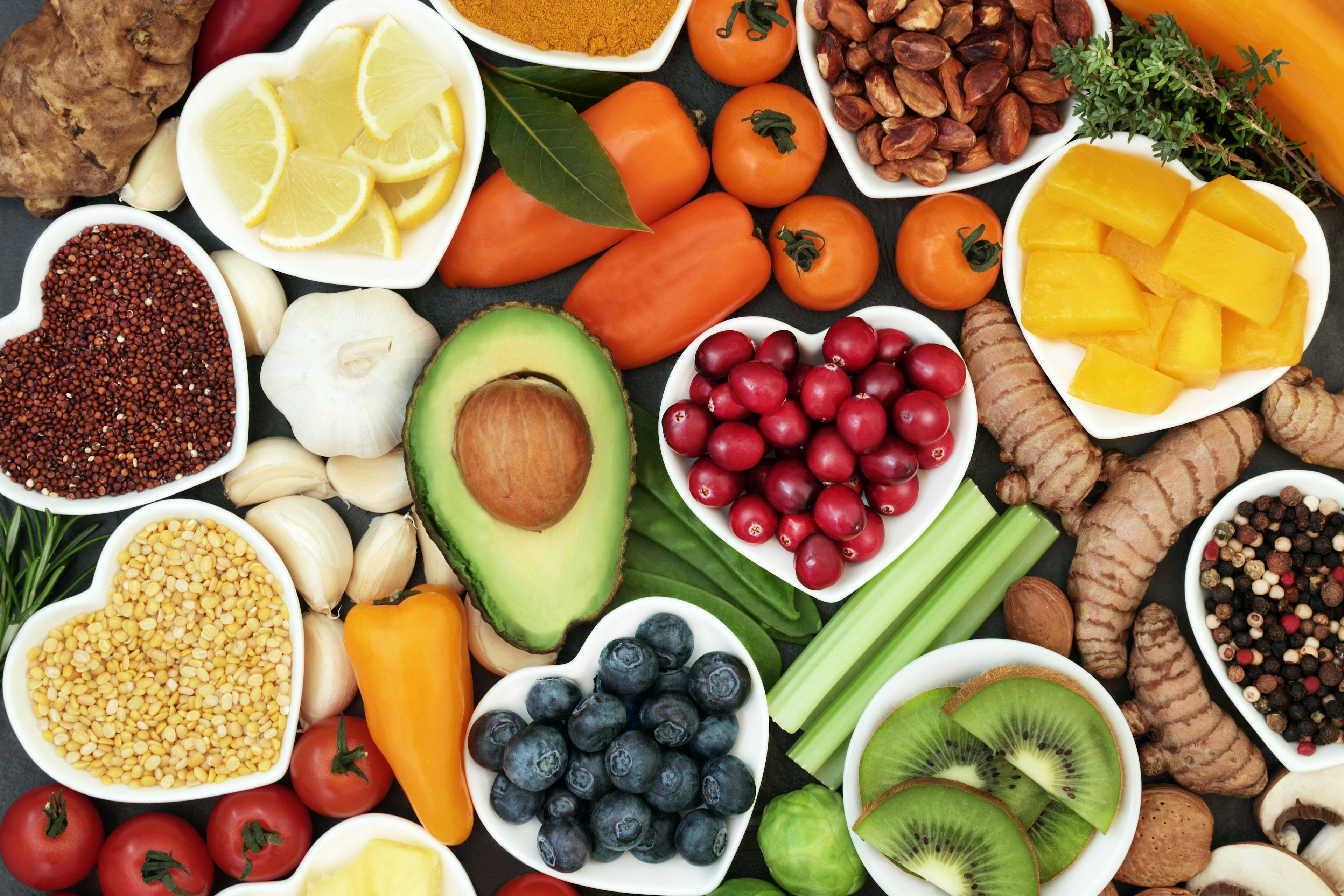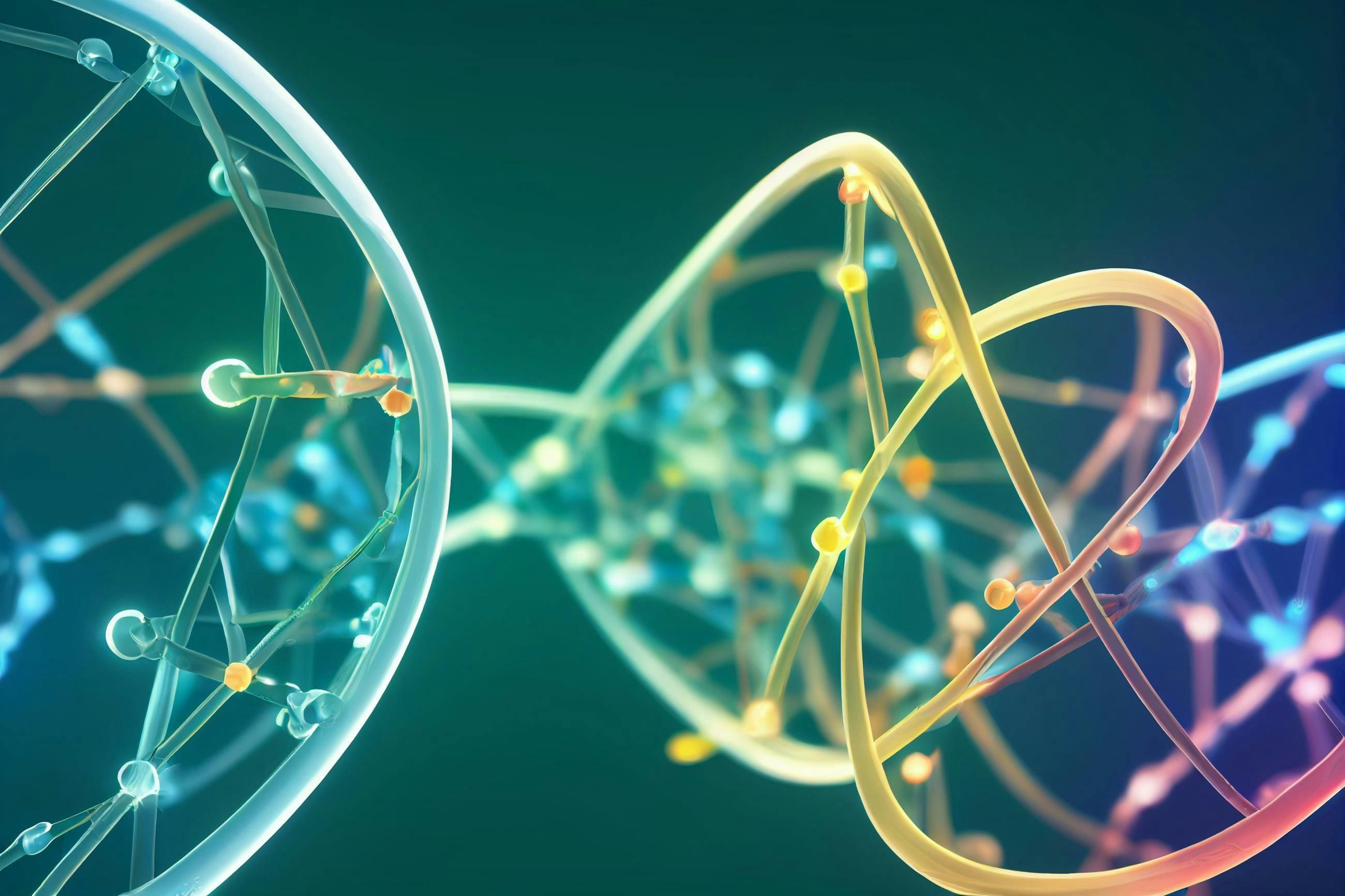Revisiting the Fundamentals of Untargeted Data Analysis with Comprehensive Two-Dimensional Gas Chromatography (GC×GC): With Great Peak Capacity, There Must Also Come Great Responsibility
This article provides a general overview of untargeted analysis using comprehensive two-dimensional gas chromatography (GC×GC), while revisiting some fundamental aspects of method development. The original definition of chemometrics is also revised according to the latest developments of the field. We discuss how GC×GC has become an important backbone for new strategies in separation science, especially in multivariate data analysis. The concept of pixel is also revisited, as an important pixel-based data processing method, namely the Fisher ratio proposed by Synovec and coworkers, has been successfully implemented in important software for GC×GC.
Separation science encompasses an amazing scope of instrumental techniques used to collect compositional information about the analytes of complex mixtures. The separation mode and column selectivity available today allows for highly efficient separations of neutral and ionizable species using gas chromatography (GC) (1). Advances in column technology have enabled faster separations with even higher peak capacities compared to the data published in the 1990s, where many disruptive techniques were being first described in the separation community, like comprehensive two-dimensional gas chromatography (GC×GC) by Liu and Phillips (2).
The seminal work of Liu and Phillips described a composite system that effectively harnessed the potential of GC×GC. In essence, two chromatographic columns were coupled in a sequential fashion and exhibited complementary solvation properties (selectivity). An interface called the modulator (originally termed on-column thermal desorption modulation [3]) multiplexed the chromatographic information of the composite system, preserving the elution profiles of the first (1D) and second dimension (2D), which allowed for the use of a single detector (2). This report quickly engaged our community and laid the foundation for continuous improvements and landmarks in GC×GC, which resulted in the exciting collection of modulation techniques based on thermal gradients (cryogen-based or cryogen-free) (4–7) and flow actuation (direct and indirect) (8–10). The diffusion and adop- tion of the technique may be (partially) illustrated by the increasing number of published articles over time, as shown in Figure 1. The interested reader is directed elsewhere to gain a better appreciation for the solid background upon which the technology was founded (3).
FIGURE 1: Published documents, including research articles and reviews, with comprehensive two-dimensional gas chromatography (GC×GC) from 1991 to 2021.
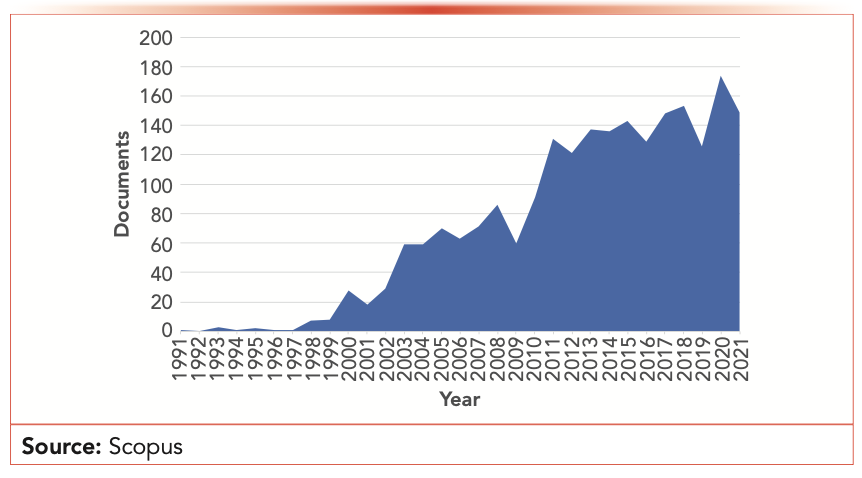
Today, GC×GC is undoubtedly one of the most powerful techniques available for mining chemical information from complex mixtures, and it has contributed to drive significant advances in related techniques like sample preparation, column technology, and, more specifically, data processing. Indeed, GC×GC has become an important backbone for new strategies, rather than being simply another tool in separation science.
“Multiplexing is a method of sending multiple signals or streams of information over a single channel simultaneously in the form of a complex or modulated signal” (11).
Untargeted analysis using GC×GC is an interesting type of application to illustrate the fundamental advances of the field. The analysis of volatile and semivolatile organic compounds by GC×GC has achieved unprecedented peak capacities, significantly reducing the occurrence of overlapped peaks. Furthermore, deconvolution tools are now integrated into commercial software (like ChromaTOF, ChromSpace, and GC Image) to recover the pure chromatographic and spectral profiles of the peaks, improving tentative (putative) identification (12). Consequently, the amount of chemical information available with GC×GC analysis can become overwhelming and it definitely challenges data processing and mining. A “hands-on” or a “one-at-a-time” data analysis workflow can still be performed (rather inefficiently) on conventional 1D chromatograms with ~30 integrated peaks. However, GC×GC chromatograms can easily result in over hundreds of integrated peaks, which reveals the need for automated methods and chemometrics for data processing. For example, Bean and co-authors reported the detection and characterization of over 500 metabolites from bacterial volatiles using solid-phase microextraction (SPME) and GC×GC–MS (13).
While processing time is often associated with efficient data mining, the recovery of chemically meaningful information is also important. The number of detectable peaks using GC×GC is much greater than in 1D-GC. Therefore, the information density in GC×GC data is significantly larger, especially when considering trace components that would be cloaked by peaks with similar first dimension retention times (1tR) (14), solvent tailing, or column bleed. Furthermore, a variety of concomitant advances in related fields has contributed positively to untargeted GC×GC analysis, as exemplified below.
“Sample preparation is often underestimated” (11,15). Our community quickly realized that GC×GC could significantly improve the synergy between gas chromatography and sorbent-based extractions. In other words, the analyst may select extractive phases primarily based on the extraction performance (such as the peak area of the analyte) without worrying about overpopulating the chromatogram with peaks due to the enhanced resolving power of GC×GC. For example, sorbents can be selected based on broad analyte coverage (16,17). This trend was observed when using conventional thermal desorption (17) and sorbent-based microextractions (18–21) in important applications at the interface of separation science and disciplines like environmental chemistry, food chemistry, and metabolomics.
“Peak distribution in the retention space” (22). The poly(dimethyldiphenylsiloxane) coatings with 5% diphenylsiloxane monomer incorporation are the most popular stationary phases for 1D-GC applications. Conversely, the demand for additional column chemistries with unique solvation properties and higher values of maximum allowable operating temperature (MAOT) have increased with the increasing popularity of GC×GC. This demand was mainly driven to improve the peak occupation of the GC×GC separation space. Hence, many column combinations were reported, as shown in Table I, exploiting solvation properties like non-specific dispersive interactions and cavity formation (l term), dipole-type interactions with permanent dipoles or polarizable moieties (s term), hydrogen-bond acidity (b term) and basicity (a term) (23,24). An interesting GC×GC column combination was described by Cochran that combined poly(cyanopropylphe nyldimethylsiloxane) and poly(ethylene glycol) in the first and second dimensions, respectively (25).
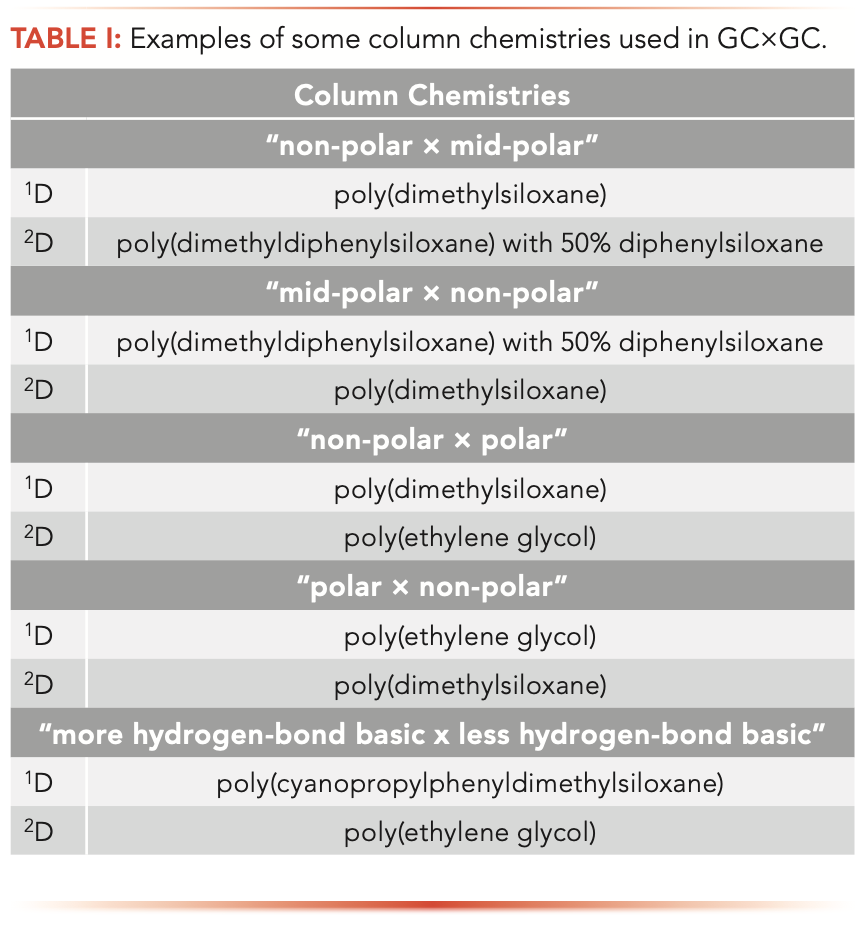
“Understanding the fundamentals of the data structure is important” (26,27). A pixel is the basic unit of intensity in a chromatogram or a mass spectrum. All data generated with GC×GC are composed of pixels. The nature of the pixel is logical rather than physical. For instance, a GC–flame ionization detector (FID) operating at 100 Hz in a 5 min experiment will generate a raw file with 30,000 individual pixels. Each pixel will store an intensity value with a temporal resolution of 0.01 s. Accordingly, a higher acquisition rate (such as 200 Hz) will improve the resolution to 0.005 s. This means that 10 pixels will be registered across a 0.1 s width peak at 100 Hz, and 20 pixels at 200 Hz. The chromatogram as we usually know it is attained by reconstruction through interpolation of the intensity values stored in the pixels. Generally, it was estimated that at least 10 pixels per peak are required for proper peak reconstruction (26,27). Accordingly, about 17 pixels per peak are recommended for multi-channel deconvolution. It can be readily seen that a column-wise vector (Figure 2, column B of data) contains the intensity information of the chromatogram, as shown in Figures 2a and 2b. The retention time is related to the index of the pixel (Figure 2, column A of data). Highlighted in green are the 15 pixels that contain the information about the analyte. The intensity of the pixels can also be visualized by plot- ting the data without interpolation (Figure 2a), also known as stick view. The conventional chromatogram is obtained by visualizing the interpolated data, as shown in Figure 2b. Accordingly, the peak area is calculated from the interpolated (“reconstructed”) chromatogram.
FIGURE 2: Illustration of a group of pixels highlighted in green, containing the intensity information of (a) the peak of the analyte, and (b) after interpolation to produce the conventional “reconstructed” chromatogram.
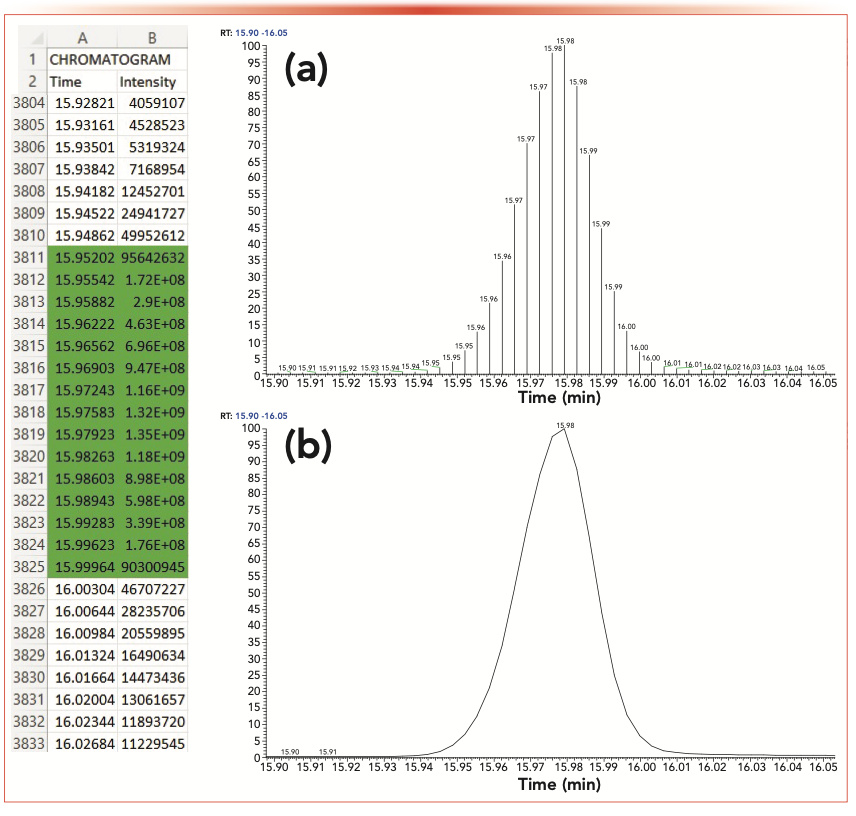
Similarly, raw GC×GC data also consist of pixels. For example, a GC×GC-FID operating at 100 Hz, a modulation period of 6 s, and a 5 min experiment will generate a raw file with 30,000 individual pixels distributed in a 600 by 50 matrix. The value of 600 (100 Hz × 6 s) corresponds to the number of pixels used to reconstruct the chromatographic profile of the 2D. The value of 50 (5 min divided by 6 s) is related to the total number of slices (or modulations) used to reconstruct the chromatographic profile of the 1D. Similarly, an acquisition rate of 200 Hz will impact only the temporal resolution of the 2D, as the number of pixels available will be 1200 (200 Hz × 6 s). In order to increase the “digitalization rate” in the 1D, the modulation period must be decreased. For instance, a 5 min GC×GC run with a modulation period of 4 s will increase the total number of modulations to 75 (compared to 50 with a modulation period of 6 s). An interesting metric called modulation ratio may be used to help in the initial selection of the modulation period (28,29). Accordingly, the acquisition rate and modulation ratio will affect the reconstruction of the peaks in the 2D and 1D, respectively. A matrix contains the intensity information of the GC×GC chromatogram, as shown in Figure 3. The retention time is related to the row (2tR) and column (1tR) index of the pixel. Highlighted in red are the pixels that contain information about the analyte. The intensity of the pixels can also be visualized by plotting the data without interpolation (Figure 3b), also known as nearest neighbor view. The conventional chromatogram is obtained by visualizing the data using linear (or bicubic) interpolation, as shown in Figure 3c. Accordingly, the peak area is calculated from the “reconstructed” GC×GC chromatogram. In other words, the pixels are used to estimate the peak area.
FIGURE 3: Illustration of a group of pixels highlighted in red, containing the intensity information of (a) the peak of the analyte. The corresponding peak is shown in the reconstructed GC×GC chromatogram (b) without interpolation and (c) with linear interpolation (such as traditional method for data visualization).
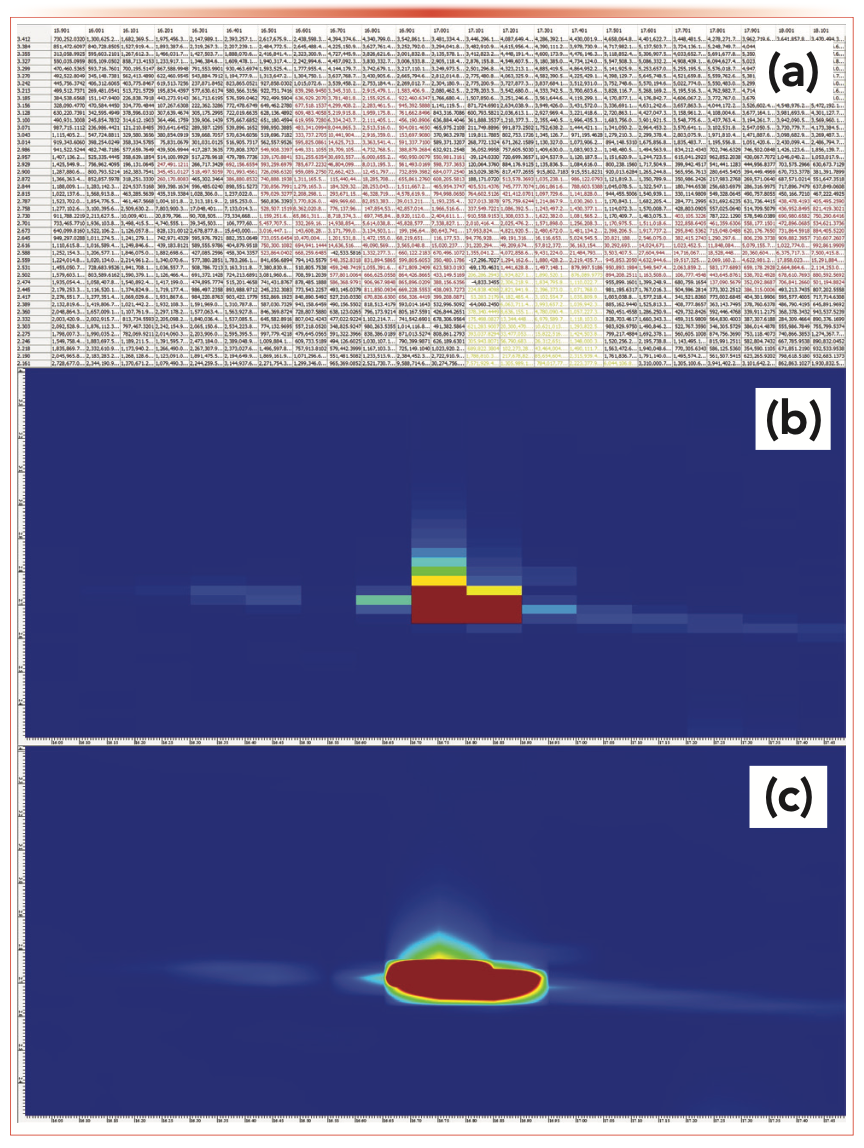
The conventional parameters extracted from the chromatogram (regardless of its the dimensionality) are based on the retention time and peak area. A generic overview of untargeted analysis is provided in Figure 4. The analyst can select different starting points, but the fundamentals required for data processing are essentially the same. For instance, traditional data processing strategies available in GC Image and ChromSpace software packages are based on a qualitative table using the peak areas of the analytes. Such an approach is termed peak table-based data processing. However, complementary approaches use the pixel as the primary input (instead of the peak areas), such as the tile-based Fisher ratio method (30,31), available both in ChromSpace and ChromaTOF Tile.
FIGURE 4: Examples of workflows for analysis of GC×GC data, including (a and b) peak table-based, and (c) pixel-based approaches. Tentative identification is also referred to as putative identification, using metrics like mass spectrum similarity index, linear temperature programmed retention index (van den Dool and Kratz [53]), mass accuracy (measured in ppm), and isotope pattern confirmation. *Denotes dependency on the scope of the study. For instance, fingerprinting methods do not necessarily require tentative identification of the analytes (for example, features).
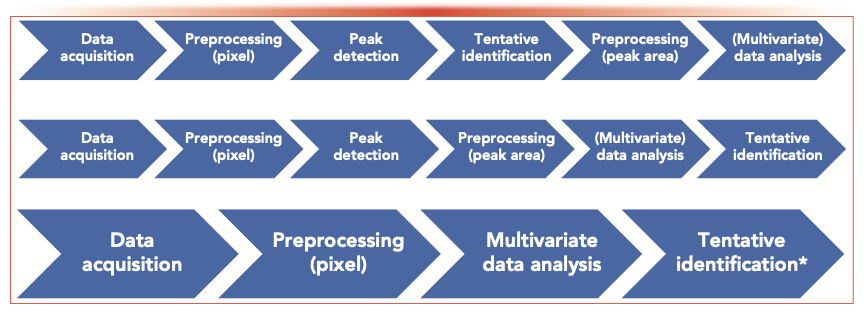
Untargeted data analysis uses chemometric methods for pattern recognition, regression, multiclass classification or one-class classification. Different algorithms are available depending on the relationship between input data (peak area or pixel) and modeled property (including, but not limited to, class, concentration, and macroscopic property). Linear models can be fitted using component-based algorithms like principal component analysis (PCA) (32), partial least squares regression (PLS) (33), discriminant analysis using partial least squares (PLS-DA) (34), and data dependent soft independent modeling of class analogy (DD-SIMCA) (35). Non-linear models can be built using neural networks and machine learning methods, like artificial neural network (ANN) (36), support vector machine (SVM) (37), and decision trees (38).
“Chemometrics is the science of relating measurements made on a chemical system or process to the state of the system via application of mathematical, statistical, or artificial intelligence methods” (adapted from Olivieri, A.C. Introduction to Multivariate Calibration (Springer, Switzerland, AG, 2018).
For most chromatography users, the peak area is the tool of choice for data processing. In conventional untargeted analysis (Figure 4a), the workflow consists of processing the pixels of the chromatograms to remove artifacts like noise, column bleed, and other contaminants by using external background subtraction, smoothing, and baseline correction. The external background subtraction generally uses a blank run to assign interfering peaks and remove their contribution to the individual qualitative table. Next, the analytes (also known as features) are detected using integration methods, which may also be accompanied by deconvolution techniques if multi-channel data is available, such as mass spectrometry (MS), or vacuum ultraviolet (VUV) detection (39). The individual peak tables are then combined into a global table for multivariate data processing, while addressing missing values and split peaks (40). After modeling, the identified variable importance in projection (VIP) may be used for interpretation of the chemometric results. Conversely, multivariate data analysis may also be performed immediately after peak detection, as shown in Figure 4b, whereas tentative identification is performed after VIP assignment. In this approach, the user can perform identification only on the peaks assigned as VIP, depending on the scope of the investigation. The interested reader is referred to these reviews on chemometrics applied to GC×GC data (41–44).
The pixel-based approach (Figure 4c) is an interesting alternative for untargeted analysis, as it bypasses two main concerns with peak detection. Low-intensity peaks are more likely to be accounted for with pixel-based approaches, as they may be disregarded during peak detection. High-intensity peaks that may exhibit non-linear chromatography (for example, overloading peaks) may be split during peak detection, while pixel-based chemometrics seemed to be largely unaffected by such non-ideal chromatography (35). However, pixel-based data processing is significantly more computationally demanding, which requires powerful and dedicated workstations for chemometrics. Also, it requires basic levels of programming to adequately explore all the resources available for multivariate data analysis. For example, a popular environment for chemometrics is MATLAB as it offers a vast array of tools that have been used with GC×GC data. For instance, the “convex hull” function (45) was used to measure the effective separation science occupied by peaks in GC×GC experiments (46). Also, many instruments exhibit non-integer data acquisition rates, which may pose a challenge for pixel-based data handling, as shown in Figure 5, but this can be mitigated through careful method development (47) or data preprocessing (48), such as the “resampling” function (49) from MATLAB. Lastly, reliable toolboxes, like PLS ToolBox (50), are readily available for the interested user, containing algorithms for multiple purposes, some of which were described in a recent LCGC North America article (51). Interestingly, artificial intelligence and free access platforms are available to help with code development for non-expert users (52).
FIGURE 5: Examples of GC×GC chromatograms of petroleum cuts obtained with non-integer and constant acquisition rate (a) with and (b) without correction (pixel padding). The effect of ion current-dependent variable acquisition rate is also illustrated (c) with and (d) without correction (resampling).
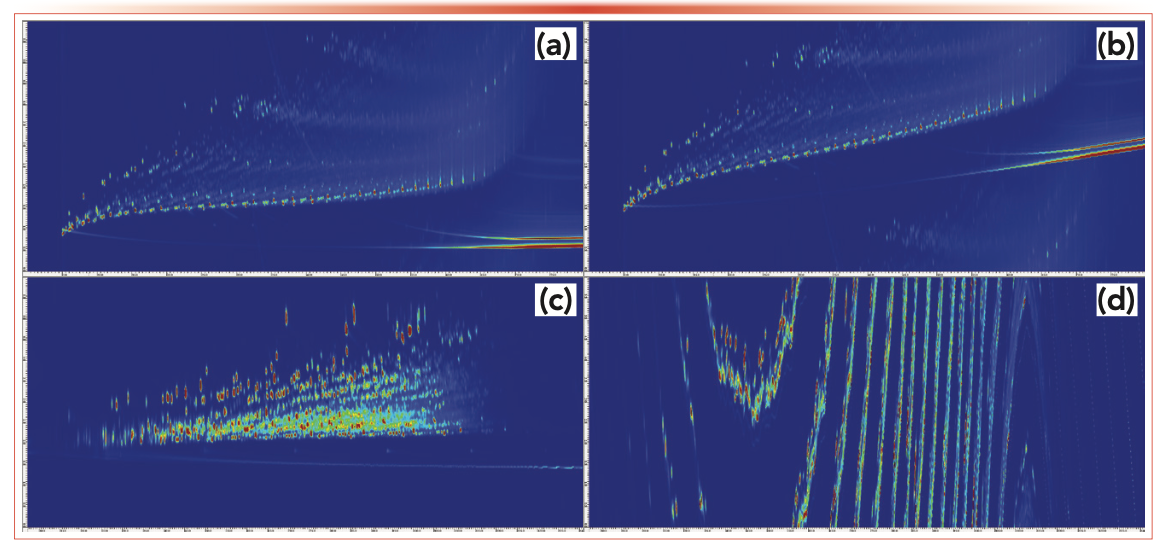
Conclusion
This article’s goal is to demonstrate the importance of understanding the fundamental concepts of untargeted data analysis, and raise awareness about the synergy between GC×GC and chemometrics for the upcoming generation of analysts in our community.
References
(1) Poole, C. F. Essence of Chromatography (Elsevier Science B.V., Amsterdam, The Netherlands, 2003).
(2) Liu, Z.; Phillips, J. B. Comprehensive Two-Dimensional Gas Chromatography using an On-Column Thermal Modulator Interface. J. Chromatogr. Sci. 1991, 29, 227–231. DOI: 10.1093/chromsci/29.6.227
(3) Dimandja, J.-M. D. Introduction and Historical Background: The “Inside” Story of Comprehensive Two-Dimensional Gas Chromatography. Sep. Sci. Tech. 2020, 12, 1–40. DOI: 10.1016/B978-0-12-813745-1.00001-5
(4) Adahchour, M.; Beens, J.; Brinkman, U. A. Th. Single-Jet, Single-Stage Cryogenic Modulator for Comprehensive Two-Dimensional Gas Chromatography (GC×GC). Analyst 2003, 128, 213–216. DOI: 10.1039/B212657P
(5) Harynuk, J.; Górecki, T. New Liquid Nitrogen Cryogenic Modulator for Comprehensive Two-Dimensional Gas Chromatography. J. Chromatogr. A 2003, 1019, 53–63. DOI: 10.1016/j.chroma.2003.08.097
(6) Pursch, M.; Eckerle, P.; Biel, J.; Streck, R.; Cortes, H.; Sun, K.; Winniford, B. Comprehensive Two-Dimensional Gas Chromatography Using Liquid Nitrogen Modulation: Set-Up and Applications. J. Chromatogr. A 2003, 1019, 43–51. DOI: 10.1016/j.chroma.2003.07.016
(7) Guan, X.; Xu, Q. Thermal Modulation Device for Two Dimensional Gas Chromatography. Patent US 8277544B2, 2010.
(8) Seeley, J. V.; Kramp, F. J.; Sharpe, K. S.; Seeley, S. K. Characterization of Gaseous Mixtures of Organic Compounds with Dual-Secondary Column Comprehensive Two-Dimensional Gas Chromatography (GC×2GC). J. Sep. Sci. 2002, 25, 53–59. DOI: 10.1002/1615-9314(20020101)25:1/2< 53::AID-JSSC53>3.0.CO;2-V
(9) Seeley, J. V.; Micyus, N. J.; McCurry, J. D.; Seeley, S. K. Comprehensive Two-Dimensional Gas Chromatography with a Simple Fluidic Modulator. American Laboratory News, 2006, 38, 24–26.
(10) Griffith, J. F.; Winniford, W. L.; Sun, K.; Edam, R.; Luong, J. C. A Reversed-Flow differential Flow Modulator for Comprehensive Two- Dimensional Gas Chromatography. J. Chromatogr. A 2012, 1226, 116–123. DOI: 10.1016/j.chroma.2011.11.036
(11) Bicchi, C. Multidimensional Character, The Analytical Scientist 2017. https://theanalyticalscientist.com/techniques-tools/multidimensional-character (accessed on 11/29/2022).
(12) Weggler, B. A.; Dubois, L. M.; Gawlitta, N.; Gröger, T.; Moncur, J.; Mondello, L.; Reichenbach, S.; Tranchida, P.; Zhao, Z.; Zimmermann, R.; Zoccali, M.; Focant, J.-F. A unique data analysis framework and open source benchmark data set for the analysis of comprehensive two-dimensional gas chromatography software. J. Chromatogr. A 2021, 1635, 461721. DOI: 10.1016/j.chroma.2020.461721
(13) Bean, H. D.; Dimandja, J.-M.; Hill, J. E. Bacterial Volatile Discovery Using Solid Phase Microextraction and Comprehensive Two-Dimensional Gas Chromatography–Time-of-Fight Mass Spectrometry. J. Chromatogr B 2012, 901, 41–46. DOI: 10.1016/j.jchromb.2012.05.038
(14) Wu, Z.-Y.; Schoenmakers, P.; Marriott, P. J. Nomenclature and Conventions in Comprehensive Multidimensional Chromatography – An Update. LCGC Europe 2012, 25, 266–275. https://www.chromatographyonline.com/view/nomenclature-and-conventions-comprehensive-multidimensional-chromatography-update (accessed on 11/29/2022)
(15) Gionfriddo, E. To Prep or Not to Prep? That is the Question...Column 2021, 17, 25–27. https://www.chromatographyonline.com/view/to-prep-or-not-to-prep-that-is-the-question-
(16) Franchina, F. A.; Purcaro, G. Sample Preparation Strategies for Comprehensive Volatile Fingerprinting. Comp. Anal. Chem. 2022, 96, 155–184. DOI: 10.1016/bs.coac.2022.02.001
(17) Franchina, F. A.; Zanella, D.; Dejong, T.; Focant, J.-F. Impact of the Adsorbent Material on Volatile Metabolites During In Vitro and In Vivo Bio-sampling. Talanta 2021, 121569. DOI: 10.1016/j.talanta.2020.121569
(18) Paiva, A. C.; Crucello, J.; Porto, N. A.; Hantao, L. W. Fundamentals of and Recent Advances in Sorbent-Based Headspace Extractions. Trends Anal. Chem. 2021, 139, 116252. DOI: 10.1016/j.trac.2021.116252
(19) Godage, N. H.; Gionfriddo, E. A Critical Outlook on Recent Developments and Applications of Matrix Compatible Coatings for Solid Phase Microextraction. Trends Anal. Chem. 2019, 111, 220–228. https://doi.org/10.1016/j.trac.2018.12.019
(20) Reyes-Garcés, N.; Gionfriddo, E.; Gómez-Ríos, G. A.; Alam, N.; Boyaci, E.; Bojko, B.; Singh, V.; Grandy, J.; Pawliszyn, J. Advances in Solid Phase Microextraction and Perspective on Future Directions. Anal. Chem. 2019, 90, 302–360. DOI: 10.1021/acs.analchem.7b04502
(21) Emmons, R. V.; Tajali, R.; Gionfriddo, E. Development, Optimization and Applications of Thin Film Solid Phase Microextraction (TF-SPME) Devices for Thermal Desorption: A Comprehensive Review. Separations 2019, 6, 39. DOI: 10.3390/separations6030039
(22) Jáčová, J.; Gardlo, A.; Dimandja, J.-M.. Adam, T.; Friedecký, D. Impact of Sample Dimensionality on Orthogonality Metrics in Comprehensive Two-Dimensional Separations. Anal. Chim. Acta 2019, 1064, 138–149. DOI: 10.1016/j.aca.2019.03.018
(23) Poole, C. F.; Poole, S. K. Separation Characteristics of Wall-Coated Open-Tubular Columns for Gas Chromatography. J. Chromatog. A 2008, 1184, 254–280. DOI: 10.1016/j.chroma.2007.07.028
(24) Poole, C. F.; Lenca, N. Gas Chromatography on Wall-Coated Open-Tubular Columns with Ionic Liquid Stationary Phases. J. Chromatog. A 2014, 1357, 87–109. DOI: 10.1016/j.chroma.2014.03.029
(25) Cheung, C.; Baker, J. D.; Byrne, J. M.; Perrault, K. A. Investigating Volatiles as the Secondary Metabolome of Piper methysticum from Root Powder and Water Extracts Using Comprehensive Two-Dimensional Gas Chromatography. J. Ethnopharmacol. 2022, 294, 115346. DOI: 10.1016/j.jep.2022.115346
(26) Tranchida, P. Q.; Purcaro, G.; Sciarrone, D.; Dugo, P.; Dugo, G.; Mondello, L. Accurate Quadrupole MS Peak Reconstruction in Optimized Gas-Flow Comprehensive Two-Dimensional Gas Chromatography. J. Sep. Sci. 2010, 33, 17–18. DOI: 10.1002/jssc.201000288
(27) Mondello, L.; Tranchida, P. Q.; Dugo, P.; Dugo, G. Comprehensive Two-Dimensional Gas Chromatography-Mass Spectrometry: A Review. Mass Spectrom. Rev. 2008, 27, 101–124. DOI: 10.1002/mas.20158
(28) Harynuk, J. J.; Kwong, A. H.; Marriott, P. J. Modulation-Induced Error in Comprehensive Two-Dimensional Gas Chromatographic Separations. J. Chromatogr. A 2008, 1200, 17–27. DOI: 10.1016/j.chroma.2008.03.008
(29) Khummueng, W.; Harynuk, J.; Marriott, P. J. Modulation Ratio in Comprehensive Two-dimensional Gas Chromatography. Anal. Chem. 2006, 78, 4578–4587. DOI: 10.1021/ac052270b
(30) Synovec, R. E. Application of Chemometrics and Related Advanced Data Handling in Chemical Separations. Trends Anal. Chem. 2022, 157, 116757. DOI: 10.1016/j.trac.2022.116757
(31) Trinklein, T. J.; Synovec, R. E. Simulating Comprehensive Two-Dimensional Gas Chromatography Mass Spectrometry Data with Realistic Run-to-Run Shifting to Evaluate the Robustness of Tile-Based Fisher Ratio Analysis. J. Chromatogr. A 2022, 1677, 463321. DOI: 10.1016/j.chroma.2022.463321
(32) Paiva, A. C.; Oliveira, D. S.; Hantao, L. W. A Bottom-Up Approach for Data Mining in Bioaromatization of Beers Using Flow-Modulated Comprehensive Two-Dimensional Gas Chromatography/Mass Spectrometry. Separations 2019, 6, 46. DOI: 10.3390/separations6040046
(33) Berrier, K. L.; Freye, C. E.; Billingsley, M. C.; Synovec, R. E. Predictive Modeling of Aerospace Fuel Properties Using Comprehensive Two-Dimensional Gas Chromatography with Time-Of-Flight Mass Spectrometry and Partial Least Squares Analysis. Energy Fuels 2020, 34, 4084–4094. DOI: 10.1021/acs.energyfuels.9b04108
(34) Paiva, A. C.; Hantao, L. W. Exploring a Public Database to Evaluate Consumer Preference and Aroma Profile of Lager Beers by Comprehensive Two-Dimensional Gas chromatography and Partial Least Squares Regression Discriminant Analysis. J. Chromatogr. A 2020, 1630, 461529. DOI: 10.1016/j.chroma.2020.461529
(35) Lima, R. A. M.; Ferraz, S. M. M.; Cardoso, V. G. K.; Teixeira, C. A.; Hantao, L. W. Authentication of Fish Oil (Omega-3) Supplements Using Class-Oriented Chemometrics and Comprehensive Two-Dimensional Gas Chromatography Coupled to Mass Spectrometry. Anal. Bioanal. Chem. 2022. DOI: 10.1007/s00216-022-04428-2
(36) Cajka, T.; Hajslova, J.; Pudil, F.; Riddelova, K. Traceability of Honey Origin Based on Volatiles Pattern Processing by Artificial Neural Networks. J. Chromatogr. A. 2009, 1216, 1458–1462. DOI: 10.1016/j.chroma.2008.12.066
(37) Beccaria, M.; Bobak, C.; Maitshotlo, B.; Mellors, T. R.; Purcaro, G.; Franchina, F. A.; Rees, C. A.; Nasir, M.; Black, A.; Hill, J. E. Exhaled Human Breath Analysis in Active Pulmonary Tuberculosis Diagnostics by Comprehensive Gas Chromatography-Mass Spectrometry and Chemometric Techniques, J. Breath Res. 2019, 13, 016005. DOI: 10.1088/1752-7163/aae80e
(38) Zhou, Y.; Gaida, M.; Franchina, F. A.; Stefanuto, P.-H.; Focant, J.-F. Distinguishing Between Decaffeinated and Regular Coffee by HS-SPME-GC×GC-TOFMS, Chemometrics, and Machine Learning. Molecules 2022, 27, 1806. DOI: 10.3390/molecules27061806
(39) Zoccali, M.; Schug, K. A.; Walsh, P.; Smuts, J.; Mondello, L. Flow-Modulated Comprehensive Two-dimensional Gas Chromatography Combined with a Vacuum Ultraviolet Detector for the Analysis of Complex Mixtures. J. Chromatogr. A 2017, 1497, 135–143. DOI: 10.1016/j.chroma.2017.03.073
(40) Bean, H. D.; Hill, J. E.; Dimandja, J.-M. Improving the Quality of Biomarker Candidates in Untargeted Metabolomics via Peak Table-Based Alignment of Comprehensive Two-dimensional Gas Chromatography–Mass Spectrometry Data. J. Chromatogr. A 2015, 1394, 111–117. DOI: 10.1016/j.chroma.2015.03.001
(41) Pollo, B. J.; Teixeira, C. A.; Belinato, J. R.; Furlan, M. F.; Cunha, I .C. M.; Vaz, C. R.; Volpato, G. V.; Augusto, F. Chemometrics, Comprehensive Two-Dimensional Gas Chromatography and “Omics” Sciences: Basic Tools and Recent Applications. TrAC–Trends Anal. Chem. 2011, 134, 116111. DOI: 10.1016/j.trac.2020.116111
(42) Pierce, K. M.; Kehimkar, B.; Marney, L. C.; Hoggard, J. C.; Synovec, R. E. Review of Chemometric Analysis Techniques for Comprehensive Two Dimensional Separations Data. J. Chromatogr. A 2012, 1255, 3–11. DOI: 10.1016/j.chroma.2012.05.050
(43) Stefanuto, P.-H.; Smolinska, A.; Focant, J.-F. Advanced Chemometric and Data Handling Tools for GC×GC-TOF-MS: Application of Chemometrics and Related Advanced Data Handling in chemical Separations. TrAC– Trends Anal. Chem. 2021, 139, 116251. DOI: 10.1016/j.trac.2021.116251
(44) Sudol, P. E.; Pierce, K. M.; Prebihalo, S. E.; Skogerboe, K. J.; Wright, B. W.; Synovec, R. E. Development of Gas Chromatographic Pattern Recognition and Classification Tools for Compliance and Forensic Analyses of Fuels: A Review. Anal. Chim. Acta 2020, 1132, 157–186. DOI: 10.1016/j.aca.2020.07.027
(45) Convex Hull. Mathworks. https://www.mathworks.com/help/matlab/ref/convhull.html (accessed on 12-05-2022)
(46) Semard, G.; Peulon-Agasse, V.; Bruchet, A.; Bouillon, J.-P. Cardinaël, P. Convex Hull: A New Method to Determine the Separation Space Used and to Optimize Operating Conditions for Comprehensive Two-Dimensional Gas Chromatography. J. Chromatogr. A 2010, 1217, 5449–5454. DOI: 10.1016/j.chroma.2010.06.048
(47) Oliveira, A. M.; Teixeira, C. A. Hantao, L. W. Advanced Tuning of the Ion Management Parameters in GC × GC-HRMS Using a Fou- rier Transform Orbitrap Mass Analyzer for Pixel-Based Data Handling and Multivariate Analysis. Anal. Methods 2022, 16, 1646–1654. DOI: 10.1039/D2AY00314G
(48) Hantao, L. W.; Teixeira, C. A.; Cavalcanti, V. H. CDF2MAT Automated SCRIPT to Import NETCDF Files to MATLAB | RESAMPLING Added to Correct RESHAPE for Non-Integer MS Acquisition Rates in GCxGC-MS Data. Harvard Dataverse 2022. https://doi.org/10.7910/DVN/WMTEMF
(49) Signal Processing ToolBox. Mathworks. https://www.mathworks.com/products/signal.html (accessed on 12-05-2022)
(50) PLS ToolBox. Eigenvector Research. https://eigenvector.com/software/pls-toolbox/ (accessed on 12-05-2022)
(51) Paiva, A. C.; Teixeira, C. A.; Cardoso, V. G. K.; Cavalcanti, V. H.; Sabin, G. P.; Hantao, L. W. Enter the Matrix: Improving the Interpretation of Separations Data Using Chemometrics in Analytical Investigations. LCGC North Am. 2022, 40, 136–139. DOI: 10.56530/lcgc.na.xx7990k6
(52) ChatGPT. OpenAI. https://chat.openai.com/auth/login (accessed on 12-06-2022)
(53) van den Dool, H.; Kratz, P. D. A Generalization of the Retention Index System Including Linear Temperature Programmed Gas—Liquid Partition Chromatography. J. Chromatogr. A 1963, 11, 463–471. DOI: 10.1016/ S0021-9673(01)80947-X
Leandro Wang Hantao is with the Institute of Chemistry, University of Campinas, in Campinas, Brazil, and the National Institute of Science and Technology in Bioanalytics (INCTBio), in Campinas, Brazil. Direct correspondence to: wang@unicamp.br
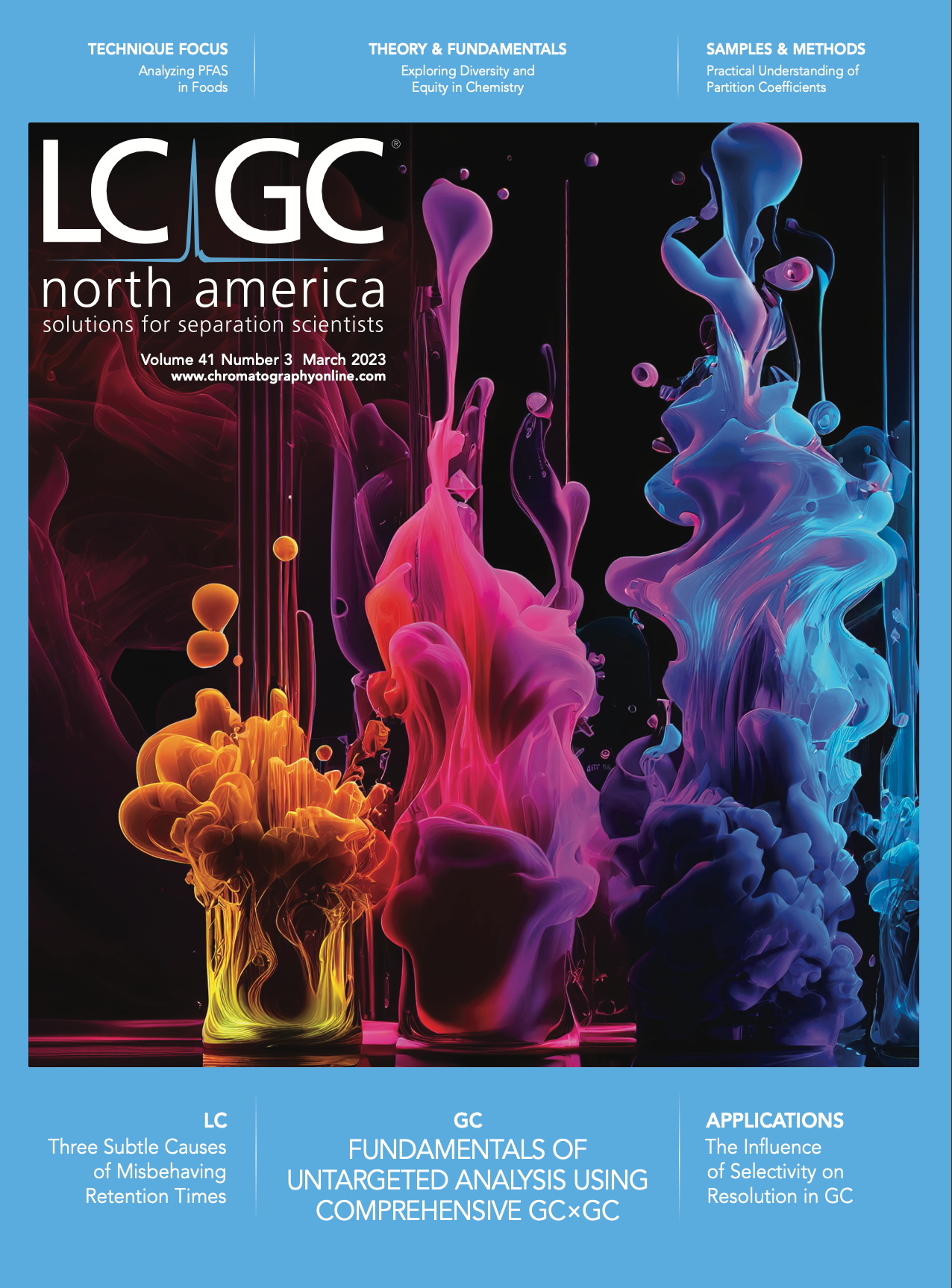
New Study Reviews Chromatography Methods for Flavonoid Analysis
April 21st 2025Flavonoids are widely used metabolites that carry out various functions in different industries, such as food and cosmetics. Detecting, separating, and quantifying them in fruit species can be a complicated process.
University of Rouen-Normandy Scientists Explore Eco-Friendly Sampling Approach for GC-HRMS
April 17th 2025Root exudates—substances secreted by living plant roots—are challenging to sample, as they are typically extracted using artificial devices and can vary widely in both quantity and composition across plant species.
Sorbonne Researchers Develop Miniaturized GC Detector for VOC Analysis
April 16th 2025A team of scientists from the Paris university developed and optimized MAVERIC, a miniaturized and autonomous gas chromatography (GC) system coupled to a nano-gravimetric detector (NGD) based on a NEMS (nano-electromechanical-system) resonator.

.png&w=3840&q=75)

.png&w=3840&q=75)



.png&w=3840&q=75)



.png&w=3840&q=75)



